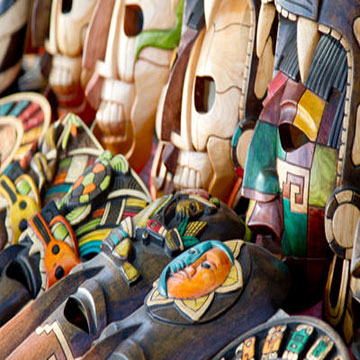 How
How best can we see a glimpse of a part of the rich Mexican culture first hand in India. An exhibition of Mexican masks at India International Centre Delhi is showcased and is scheduled to continue till July 31.
Numerous characters from Mexican legends and myths have been brought to life in this unique exhibition here featuring over 33 different types of masks that are used in various festivals across Mexico.
Made from different mediums - lacquered wood carving, polychrome clay, ceramic, metal, fabric and plastic etc, the masks exhibited in the show are used in over 4,000 different celebrations held throughout the year across different states of the country.
"A marvellous instrument, the mask hides the wearer while at the same time it acquires life and becomes a God, a deity, an animal or maybe a king. It becomes a passport to a different world or time," says Melba Pría, Mexican Ambassador to India.
"Most of the masks exhibited in the show are used for dance-drama performances in Mexico. These are a kind of theatre performance in which dancers and audience recreate sacred myths, legends and historical events," she says.
Among the most popular of the characters depicted through the masks include the 'Devil' which is symbolic of the process of evangelisation and introduce the concepts of good, bad and punishment.
The 'Jaguar' or the 'Tiger', which is also considered the most sacred animal, is often shown to play a double role - of both good and evil.
Some masks refer to pre-Hispanic deities while the 'Old Men' also play the role of ceremonial buffoons, mocking the fragility of the elderly and making the audience laugh with their antics.
Among animal masks are species native to the Americas, with particular significance among pre-Hispanic populations like alligator, monkey, boar, birds, turtles etc.
Before the Spanish conquest in 16th century, the North American country was home to over one hundred ethnic groups and masks and costumes were an integral part of their rituals.
The ruling theocrats took on the characteristics of the Gods in their ceremonies, using imitative magic to control the forces of nature and the cosmic struggles.
While masks from most of the Mexican states at the show appear to be animals with sharp canines, protruding horns or an odd shaped noses, those from areas like Chiapas, Tlaxcala and Michoacan are more human-like, likely to remind one of characters from William Shakespeare's plays.
Incidentally much like the Elizabethan age in Europe, women do not participate in dances with masks.
"The masked female characters are always played by men dressed up as women, a practice popular in Europe during the 15th century that has survived until the present," Pría says.
Beside being used in celebrations, mask making is treated as a form of art in itself in the country where masks are also made for tourists and collector.
"The masks can be seen as a work of art by itself. They are sculptures through which the mask maker can unleash his creativity.
"They are also canvases in which one community interprets a topic in its own way. There are recurring themes and it is interesting to see different regions characterise these themes in their local context," says Pria.
According to her Mexico and India are two incredibly diverse regions but they share some of the richest mask traditions.
"They are both ancient practices that reflect the diversity and rich heritage of our native cultures. Both are used as important props in folk dances and celebrations, like in the Chhau festival in East India. "Although the characters may be different, both traditions use masks to represent a character and for the dancer to take over certain features that are necessary to tell a story," she says.
 How best can we see a glimpse of a part of the rich Mexican culture first hand in India. An exhibition of Mexican masks at India International Centre Delhi is showcased and is scheduled to continue till July 31.
How best can we see a glimpse of a part of the rich Mexican culture first hand in India. An exhibition of Mexican masks at India International Centre Delhi is showcased and is scheduled to continue till July 31. 